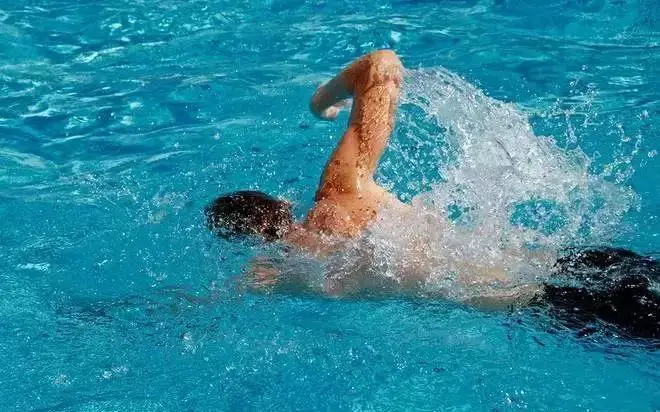
Most people have heard about shingles, also known as herpes zoster, at least once in their life. Thus, everyone knows what it is, yet, there seems to be a lot of confusion surrounding this condition. For example, many people don’t know how contagious it is, or how to treat it, or whether or not it causes pain.
However, in this article, the question that will be addressed is “can I go swimming with shingles”, since this question particularly is one that many people don’t know the answer to. Consequently, if you’re one of those people, keep reading to find out the answer!
Can I Go Swimming With Shingles?
Table of Contents
Now, the answer is a rather nuanced one. Namely, whether or not you’re allowed to go swimming in a public pool when you have shingles depends entirely on the phase of the infection you’re going through exactly. This might sound complex, but it’s actually really straightforward as will be illustrated in the following text.
That is to say, in the first instance, it’s not a very good idea to go swimming in a public area if you’re infected with the virus that causes shingles. Even more so, it’s quite the opposite! To make this less abstract, when you have shingles, you’ll find that you’ll encounter painful, burning, and itchy blisters on several places of your body. At first, these blisters will not only itch and burn like crazy, but you’ll also find that they will be filled with fluid. Afterward, the blisters will slowly start to burst open, so to speak. Well, it is exactly in this phase of your infection that you’re the most likely to spread the virus to other people since you’ll be highly contagious when your blisters aren’t covered.
However, after about 7 to 10 days(but remember that it can take longer than this), the healing process will surely begin to manifest itself. During this process, the fluid in your itchy blisters will gradually start to dry out. This is really important to remember since this can only be described as a true turning point when it comes to a shingles infection. After the fluid has dried out completely, your blisters will slowly get crusted.
When you have reached this moment, you will no longer be contagious to other people and you will be totally allowed to go swimming in public areas as much as you like. Hence, the moral of the story is to just wait it out and to remember that it’s always better to be safe than sorry, especially taking into account that this concerns your health as much as it concerns the health of the people around you! The shingles virus is extremely easy to pass on so you really don’t want to take any chances in this department, which is why it’s so crucial to avoid spreading it!
Side-Note
However, just because it’s okay to go swimming when you’re no longer contagious, there are still a couple of things you have to keep in the back of your mind at all times. For example, even when crusts have formed over your blisters, you should remember that it’s absolutely not recommended to start sharing towels or such when you’re done swimming in a public pool. That is, it’s always possible that there’s still one blister that hasn’t healed completely yet and if that’s the case, there’s a very real risk of the virus spreading, which is something to avoid at all costs. Besides that, it’s also just not a very hygienic thing to do so it’s better to avoid it altogether.
Other Pertinent & Related Questions
How To Recognize You Have Shingles?
One question in particular that gets asked a lot in regards to shingles is how to recognize that you have it. Well, it’s actually quite hard not to. While it’s certainly the case that not every person experiences the associated symptoms to the same extent, there are still several symptoms that generally resurface in most cases.
More concretely, most people have flu-like symptoms such as a fever, headache, or a general feeling of sickness. In addition to this, most people also suffer from pain, itching, and even burning on the body part that will later be affected by the aforementioned blisters. This brings us to the most typical symptom of them all: the blisters. After a couple of days, people with shingles will experience red spots and fluid-filled blisters anywhere from the torso to the face. What’s particular about the shingles virus is that it causes blisters that more often than not, will only affect one side of the body. Hence, if this sounds familiar to you, this could definitely be a clear sign that you’re infected with the virus.
Does Having Shingles Hurt?
This next question might be related to the previous one, but it still deserves a clear answer, however short it might be. That is to say, in most cases, having shingles can be rather painful, for sure. Often, people infected with the virus even describe the pain as extreme, especially when one reaches the blister phase.
Even more so, even once the blisters have completely healed, there’s a high chance that you will keep on experiencing pain in the affected area. This can even keep lasting for months in extreme cases! The reason behind this is that certain nerves can get inflamed as a result of the virus.
How Can I Treat Shingles?
Luckily, shingles usually go away on their own most of the time. Namely, if you’re infected with the virus, it’s highly likely that in 1-4 weeks, your body will recover by itself without any treatment. Nonetheless, you can rub certain ointments such as zinc ointments on your blisters to lessen the itchiness or you could take painkillers like paracetamol to soothe the pain if you think it’s necessary. However, these treatments aren’t meant to treat shingles directly.
Furthermore, while medication and treatment aren’t in order more often than not, this is only a rule of thumb and not a strict principle that applies all the time for everyone. To be more concrete, when there are complications or when talking about people with a compromised immune system, further methods and treatments might be necessary. Then, it could be so that your doctor prescribes you certain virus inhibitors to keep the damage to a minimum, especially when you have shingles in your face.
Can I Have Shingles Twice?
The sad answer is yes, it’s possible to have shingles twice or even more than that throughout your life. However, the good news is that this generally doesn’t happen with healthy people with a strong immune system. Also, once you get through a shingles infection, your body will automatically produce antibodies, making it even less likely that you will have to experience this impractical condition again.
Nevertheless, there definitely are people who do experience it more than once and that’s usually because those people have issues with their immune system. That is, the groups that are most targeted with this condition are people with a low immune system or people from the older generation, so it also shouldn’t come as a surprise that it’s more likely for these people to suffer from shingles more than once.
What Is The Link Between Shingles And Chickenpox?
Well, the link between shingles and chickenpox is the virus behind all of it. That is to say, both conditions are caused by an infection with the same virus, the Varicella-Zoster Virus. Most people get infected with the chickenpox virus during the early years of their childhood, meaning that they will get chickenpox very early on in their life. However, the particular thing about this virus is that it doesn’t go away. It’s quite to contrary, it stays lurking in your body even after you have healed completely from chickenpox.
However, in some people, the virus becomes active again, so to speak and that’s precisely what causes shingles. Hence, you could also regard a shingles infection as a late manifestation of the chickenpox virus. A consequence of all of this is that if you have never been infected with the chickenpox virus throughout your life, it’s impossible to have shingles. On the other hand, if you have shingles and you come in contact with someone who has never been exposed to the virus, it’s possible for that other person to develop chickenpox because they won’t have any antibodies!
When Should I Call My Doctor?
As mentioned above, shingles often don’t require any treatment at all. However, if you have blisters very close to your eye or ear, or you suffer from loss of hearing or sight, it’s definitely wise to contact your doctor. Your doctor will prescribe you medication to prevent permanent damage to your eyes or ears.
Moreover, if you have a compromised immune system, it’s also a good idea to contact your doctor so they can prescribe you virus inhibitors. The same can be said about the scenario in which you have an unusually high amount of pain or blisters. That’s because, in these particular cases, your body likely won’t recover on its own.
Conclusion
All in all, once you have left the contagious phase of your shingles infection, it’s completely fine to take a dive in a public pool. However, please make sure that you take all the required measures and precautions to be as safe as possible and to avoid spreading the virus further at all costs. Additionally, if you don’t exactly know what this all entails or if you have any other questions regarding the virus, don’t hesitate to contact your doctor or other healthcare providers. They will undoubtedly be more than happy to help you!

